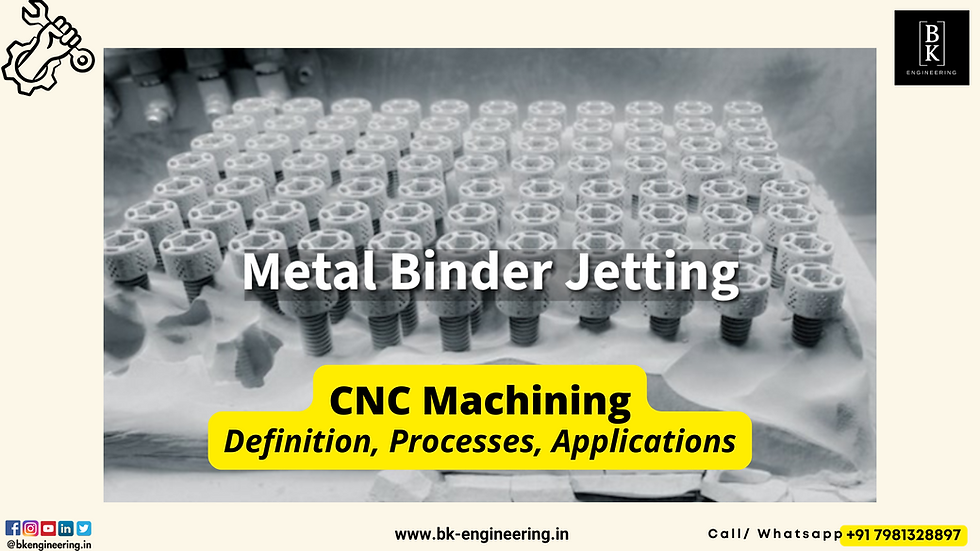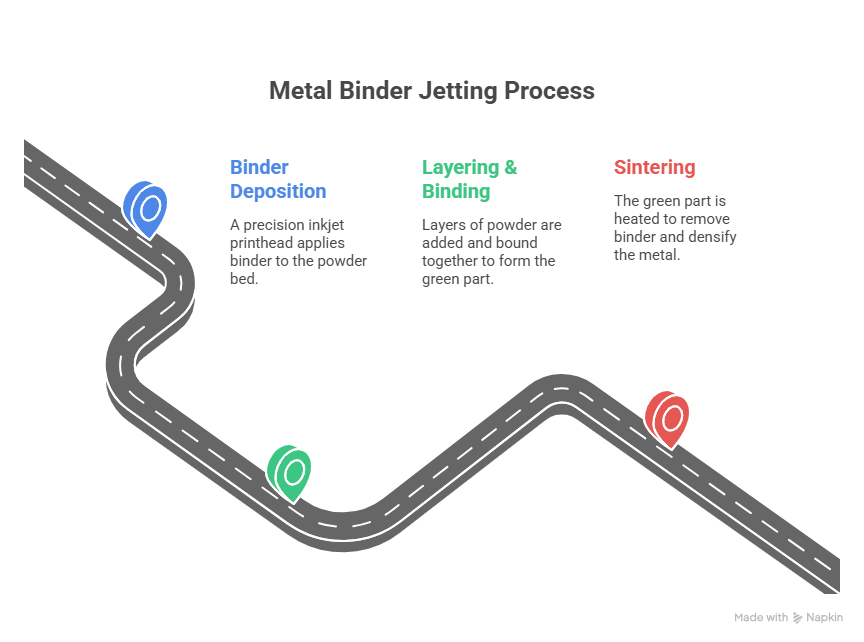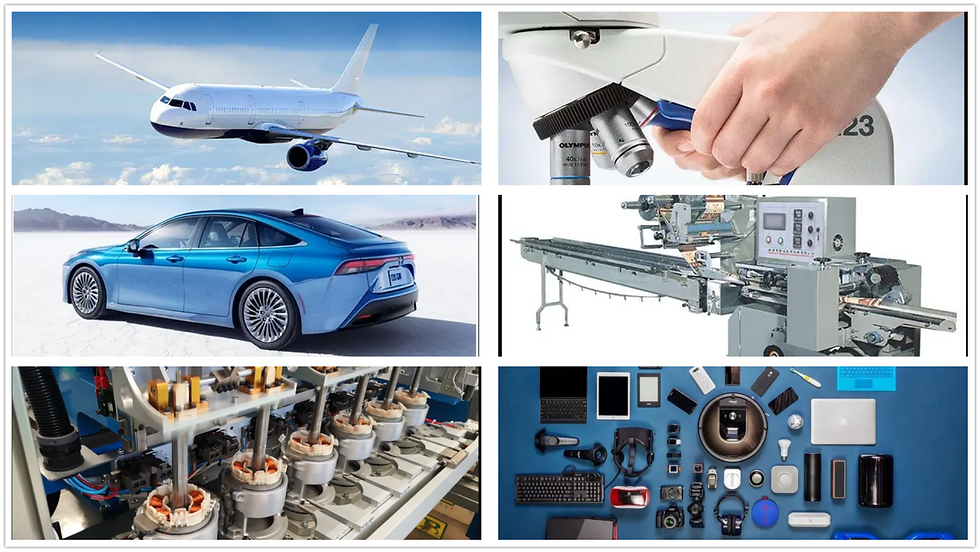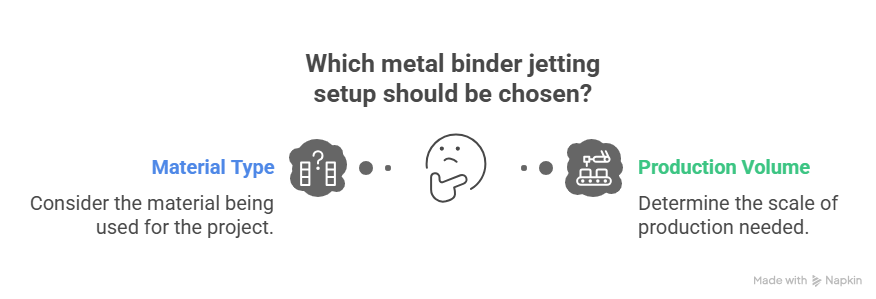Metal Binder Jetting: The Ultimate Guide to Metal 3D Printing for Mass Production
- shiva ganesh
- Jul 30
- 4 min read
Table of Content

Introduction to Metal Binder Jetting
What is Metal Binder Jetting?
Metal Binder Jetting (MBJ) is an additive manufacturing process that prints metal parts by selectively depositing a liquid binder onto layers of metal powder. After printing, the "green" parts are sintered in a furnace, where the binder burns away and the meta
Metal Binder Jetting vs. Other Metal 3D Printing Technologies
Key Differencesl particles fuse to form a solid, dense structure.
Unlike laser-based metal 3D printing, Binder Jetting doesn't use heat during printing, making it faster, more scalable, and more cost-effective for high-volume production of metal parts.
A Brief History of Metal Binder Jetting
Binder Jetting technology was first introduced in the 1990s at MIT. Over time, companies like ExOne (now part of Desktop Metal), HP, and GE Additive have advanced MBJ to a reliable production-level solution. Today, it's gaining widespread adoption for producing complex, lightweight, and cost-efficient metal components at industrial scales.
Cost Considerations
How Metal Binder Jetting Works
The Basic Workflow

Design the part in CAD software.
Slice the model into layers via Binder Jetting software.
Print: A printhead selectively deposits binder onto a metal powder bed, layer by layer.
Depowder: Remove excess powder after printing.
Cure: Harden the green part with heat or chemicals.
Sinter: Furnace processing burns away the binder and densifies the metal.
Optional Post-Processing: Infiltration, machining, or surface finishing.
Key Components of Metal

Binder Jetting Printers
Printhead
Applies a liquid binder selectively to fuse powder particles temporarily.
Powder Bed
A fine layer of metal powder is spread for each layer.
Recoater
Distributes thin, uniform powder layers across the build area.
Build Platform
Supports multiple parts simultaneously in a single batch.
Metal Binder Jetting Process

Binder Deposition
A precision inkjet printhead applies the binder only where the part geometry exists.
Layering & Binding
The process repeats layer-by-layer until the full "green part" is for
Tips for Getting Started with Metal Binder med within a box of loose powder.
Sintering
Post-print, the green parts are heated in a furnace to eliminate the binder and densify
Choosing the Right Metal Binder Jetting Setupthe structure to near-solid metal.
Materials Used in Metal Binder Jetting

Common Metal Alloys
Stainless Steels (316L, 17-4PH)
Corrosion resistance, strength for tooling, medical, and consumer goods.
Inconel (625, 718)
Nickel-based alloys for high-temperature, corrosive environments.
Copper
Excellent electrical and thermal conductivity applications.
Tool Steels (H13, M2)
For high-wear industrial tools, dies, and molds.
Titanium (under development)
Emerging but less common than in DMLS or EBM.
Aluminum (limited availability)
Still maturing due to sintering challenges.
Applications of Metal Binder Jetting

Automotive
Brackets, housings, gears, and structural components for light weighting and performance.
Consumer Goods
Custom jewelry, hardware, kitchen tools, and wearables.
Medical
Surgical instruments, orthopedic devices (limited use compared to DMLS).
Industrial Tooling
Dies, molds, cutting tools, fixtures.
Energy & Electronics
Heat sinks, conductive parts, complex geometries.
Advantages of Metal Binder Jetting

Scalability
Multiple parts in a single build; ideal for batch production.
Cost-Effective
Lower part cost for volume production compared to laser-based methods.
High Throughput
Large build volumes and fast print speeds.
Complex Geometries
Internal channels, lattice structures, and consolidated assemblies.
No Supports During Printing
Parts are supported by surrounding loose powder, simplifying design.
Limitations of Metal Binder Jetting

Requires Sintering
Significant shrinkage and deformation risk during furnace processing.
Material Density
Typically achieves 95-99% density, slightly less than DMLS or forged parts.
Surface Finish
Surface roughness is moderate and often requires finishing.
Limited High-Performance Alloys
Not all metals sinter well; options are more limited than laser systems.
Post-Processing Complexity
Debinding, sintering, infiltration, or machining are necessary steps.
Metal Binder Jetting vs. Other Metal 3D Printing Technologies
Key Differences
Feature | Binder Jetting | DMLS / SLM | EBM | DED |
Energy Source | Liquid binder + furnace | Laser | Electron Beam | Laser / Electron |
Supports | No supports needed | Required | Required | None / Minimal |
Build Speed | Fast | Moderate | Moderate | Slow |
Best Use | High-volume production | High-performance parts | Aerospace parts | Repairs, Large |
Surface Finish | Moderate (post-process) | Fine (post-process) | Rough | Rough |
When to Choose Metal Binder Jetting
For large batch production of small to medium parts.
When cost-efficiency outweighs maximum strength.
For complex parts not requiring ultra-high precision.
Future Trends in Metal Binder Jetting

Material Expansion
Improved sintering methods for aluminum, titanium, and more complex alloys.
Automation & Scalability
Streamlined depowdering, sintering, and finishing for higher throughput.
Hybrid Manufacturing
Binder Jetting for complex geometries combined with machining for precision.
Industry Adoption
Automotive and consumer sectors driving mass production adoption.
Cost Considerations

Machine Cost
Ranges from ₹70 lakhs to ₹3 crores, depending on build volume and speed.
Operational Costs
Metal powder is cheaper than laser-grade powders.
Post-processing adds costs for sintering, infiltration, finishing.
Part Cost
Lower than DMLS for batch production.
Parts typically ₹500 to ₹10,000+ depending on complexity and size.
Choosing the Right Metal Binder Jetting Setup

Based on Material
Stainless Steel, Inconel, Copper: Most common and mature.
Aluminum, Titanium: Emerging, still limited.
Based on Production Volume
Mid-to-high batch production: Binder Jetting is ideal.
Prototypes or single parts: DMLS / SLM may offer more control.
Tips for Getting Started with Metal Binder

Jetting
Design for Sintering
Account for shrinkage, powder removal, and warpage during furnace processing.
Plan Post-Processing
Ensure you understand the need for machining, infiltration, polishing.
Evaluate for Scale
Binder Jetting shines in batch runs, not small prototype series.
Work with Experts
Partner with experienced service bureaus or OEM-certified providers.
Conclusion

Metal Binder Jetting is redefining scalable metal 3D printing by offering cost-effective, high-volume, complex part production. While it requires careful post-processing, it provides unmatched value for industries seeking rapid, affordable metal manufacturing at scale.




Comments